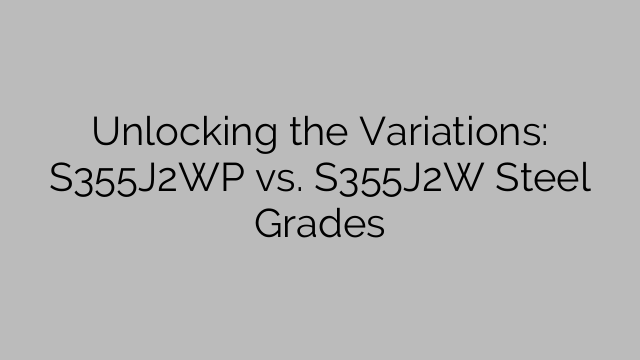When it comes to steel grades, there are numerous options available in the market, each designed for specific applications and environments. One such comparison that often arises is between two closely related steel grades: S355J2WP and S355J2W. While they may appear similar, there are key differences that set them apart.
S355J2WP and S355J2W are both weathering steel grades, which means they are primarily used for outdoor structural applications where exposure to the elements is a factor. Their enhanced resistance to corrosion and atmospheric conditions make them ideal for bridges, building facades, and other structures that need to withstand harsh weather conditions.
The main difference between these two steel grades lies in the additional alloying elements present in S355J2WP. The “WP” in its name stands for “weathering, with improved atmospheric corrosion resistance.” This is achieved by the alloying elements, such as copper, chromium, nickel, and phosphorus, which are added to the steel composition.
Copper is a key element in S355J2WP, as it creates a protective patina on the steel’s surface, inhibiting further corrosion. Chromium and nickel enhance the steel’s corrosion resistance, even in aggressive environments. Phosphorus improves the steel’s atmospheric corrosion resistance, enabling it to withstand exposure to rain, snow, and moisture.
On the other hand, S355J2W does not contain these additional alloying elements. While it still provides good atmospheric corrosion resistance, it may not be as effective as S355J2WP in extremely corrosive environments or in the presence of marine conditions.
In terms of mechanical properties, S355J2WP and S355J2W both have similar tensile and yield strength, making them suitable for structural applications. They also have excellent weldability and formability, allowing for easy fabrication and construction.
When selecting between S355J2WP and S355J2W, it is vital to consider the specific environmental conditions the steel grade will be exposed to. If the structure will be in an environment with high levels of moisture, saltwater, or other corrosive elements, S355J2WP may be the better choice due to its enhanced corrosion resistance. However, for less aggressive environments, S355J2W can still provide sufficient durability and cost-effectiveness.
It is worth noting that both steel grades comply with the European standard EN 10025-5, ensuring their quality and performance. Additionally, their weathering properties eliminate the need for painting, saving time and maintenance costs.
In conclusion, the choice between S355J2WP and S355J2W steel grades depends on the specific environmental conditions and corrosive factors the structure will be exposed to. While S355J2WP offers improved corrosion resistance with the addition of alloying elements, S355J2W still provides satisfactory performance in less extreme conditions. Consulting with a steel expert can help make an informed decision and maximize the longevity of the structure.

